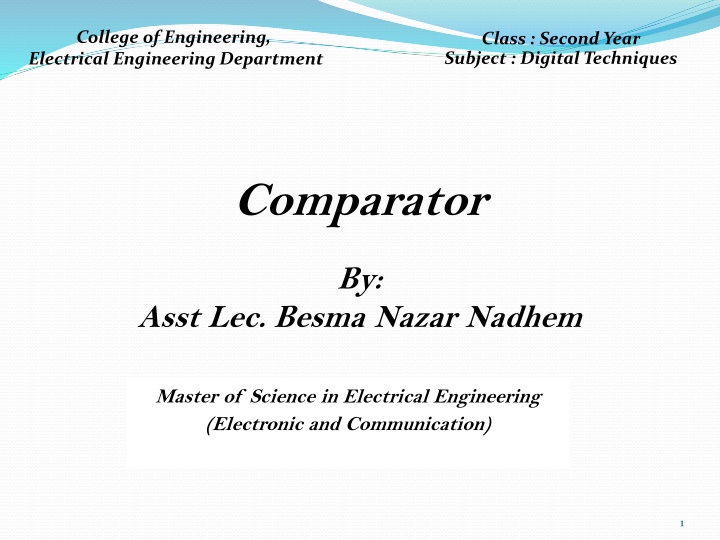
Digital Techniques Comparator in Electrical Engineering Department
Learn about magnitude comparators in digital techniques used in electrical engineering. Understand how binary numbers are compared, truth tables, and examples using ICs and comparators to design circuits.
Download Presentation

Please find below an Image/Link to download the presentation.
The content on the website is provided AS IS for your information and personal use only. It may not be sold, licensed, or shared on other websites without obtaining consent from the author. If you encounter any issues during the download, it is possible that the publisher has removed the file from their server.
You are allowed to download the files provided on this website for personal or commercial use, subject to the condition that they are used lawfully. All files are the property of their respective owners.
The content on the website is provided AS IS for your information and personal use only. It may not be sold, licensed, or shared on other websites without obtaining consent from the author.
E N D
Presentation Transcript
College of Engineering, Electrical Engineering Department Class : Second Year Subject : Digital Techniques Comparator By: Asst Lec. Besma Nazar Nadhem Master of Science in Electrical Engineering (Electronic and Communication) 1
Magnitude Comparator A magnitude comparator is a combinational circuit that compares two given numbers and determines whether one is equal to, less than or greater than the other. The output is in the form of three binary variables representing the conditions A = B , A>B and A<B, if A and B are the two numbers being compared The function of each gate can be represented by a truth table or using Boolean notation
For two binary numbers , each one have one bit , the truth table : Z1 Z2 Z3 A B A>B A=B A<B 0 0 0 1 0 0 1 0 0 1 1 0 1 0 0 1 1 0 1 0 Z1(A>B) = AB Z2(A=B)=A B Z3(A<B)=AB A < B A Magnitude Compare A = B B A > B
For two binary numbers , each one have two bits (n=2) A=A1A0 B=B1B0 A>B=(A1>B1)OR(A1=B1)AND(A0>B0) A>B=A1B1+(A1 B1)(AoBo) A<B=(A1<B1)OR(A1=B1)AND(A0<B0) A<B=A1B1+(A1 B1)(AoBo) A=B=(A1=B1)AND(A0=B0) A=B=(A1 B1)(Ao Bo) A > B A < B A =B
7485 IC Two binary numbers 4 bits comparator Ao A1 A2 A3 > 0 = 1 7485 IC 0 < Bo B1 B2 B3
Example : Use 7485 IC to compare two binary numbers each one have eight bits A=A7A6A5A4A3A2A1A0 B=B7B6B5B4B3B2B1B0 A4 A5 A6 Ao A1 A2 A7 A3 > G > > 0 = > = < E = 7485 IC = 1 7485 IC < L 0 < < B4 B5 Bo B1 B6 B7 B2 B3
Example : Design H.A using Comparator only : Solution : S=AB+AB=A B Co= AB > A1 A A 1 S=A B = < 1 B A1 =A Co=AB















